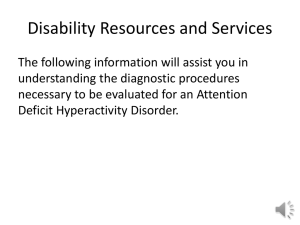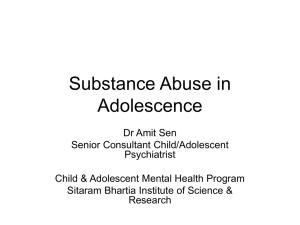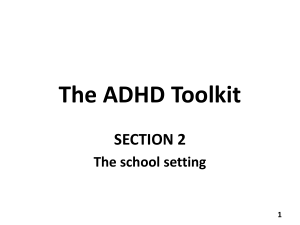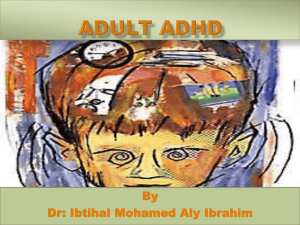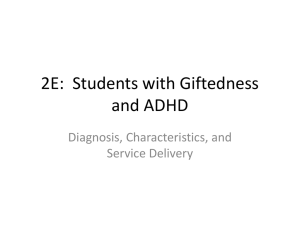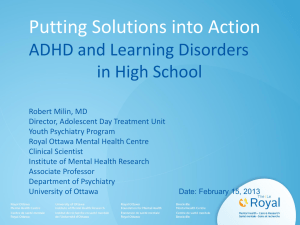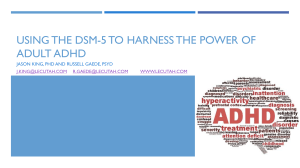(i) the `causes`
advertisement
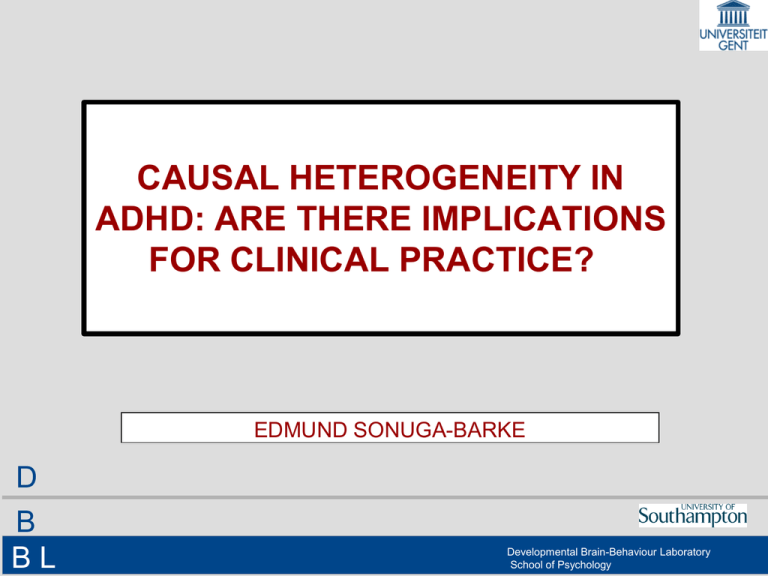
CAUSAL HETEROGENEITY IN ADHD: ARE THERE IMPLICATIONS FOR CLINICAL PRACTICE? EDMUND SONUGA-BARKE D B BL Developmental Brain-Behaviour Laboratory School of Psychology OVERVIEW • DSM-IV ADHD subtypes – A successful way to handle heterogeneity? • New approaches to ADHD subtyping. – Statistical refinement of the clinical phenotype. – Towards translational taxonometrics. • Neuropsychological markers of multiple causal pathways in ADHD. – Executive dysfunction – Delay aversion – Temporal processing • Implications: Treatment tailoring to subtype targets? DSM-IV ADHD SUBTYPES – A SUCCESSFUL WAY TO HANDLE HETEROGENEITY? ADHD: THE CLINICAL REALITY Patients present with a range of clinical profiles with varying types and degrees of; (i) symptoms of inattention, impulsivity/hyperactivity; (ii) comorbidity; (iii) complicating factors; and (iv) impairment. They may appear so different from one another that it is sometimes difficult to see them as having the same disorder. THE DIAGNOSTIC REIFICATION That this heterogeneity masks a core syndrome marked by a cluster of symptoms which can be distinguished from normality and from other related conditions and abstracted from local complicating factors and types of impairment. HETEROGENEITY IN SYMPTOM PROFILE INATTENTION HYPER/IMPULSIVE ATTENTION! S E V E R I T Y Hyperactivity/Impulsivity Inattention ADHD: THE CLINICAL REALITY Patients present with a range of clinical profiles with varying types and degrees of; (i) symptoms of inattention, impulsivity/hyperactivity; (ii) comorbidity; (iii) complicating factors; and (iv) impairment. They may appear so different from one another that it is sometimes difficult to see them as having the same disorder. THE DIAGNOSTIC REIFICATION Heterogeneity masks a core syndrome category marked by a cluster of symptoms which can be distinguished from normality and from other related conditions and abstracted from local complicating factors and types of impairment. ADHD IS A DIAGNOSTIC ABSTRACTION HANDLING HETEROGENEITY IDENTIFYING SUBTYPES THE CREDIBILITY OF THIS CATEGORICAL VIEW DEPENDS ON OUR ABILITY TO PARTITION HETEROGENEITY IN CLINICALLY PLAUSIBLE WAYS. A number of approaches have been explored that address the putative causes of heterogeneity. (I) Gender – Are there separate male and female ADHD? (II) Severity and pervasiveness – ADHD vs HKD? (III) Familiality – Is ADHD different if it runs in the family? (IV) Onset and persistence – Is adult onset a valid ADHD type? (V) Comorbidity – Is HK-CD a subtype or HKD with a comorbid condition? (VI) Uneven symptom profile – Are differences between inattentive and hyperactive/impulsive types of aetiological and clinical significance? DSM-IV SUBTYPES 6 of 9 H/I & 6 of 9 IA symptoms Com Type ADDITIONAL DIAGNOSTIC CRITERIA Some symptoms/impairment before age 7 years; Some impairment in two or more settings ;Clinically significant impairment; Not accounted for by another disorder THE VALUE OF DSM-IV SUBTYPES Hyp/Imp and Inatt are overlapping but separate dimensions. However subtypes.... not stable over time little genetic/familial specificity poor neuropsychological discrimination Little or no differential treatment response Poor evidence for the validity of the ADHD subtypes. HYP/IMP – PERHAPS A PRODROMAL FORM OF CT. IA – PERHAPS SUB-THRESHOLD OR OTHER DISORDER. Todd et al., 2008, McLoughlin et al 2007, Willcut et al, 2007, Gorman et al. 2006 THE FAILURE OF DSM-IV SUBTYPES: FUNDAMENTAL QUESTIONS. Why ‘split’ rather than ‘lump’ anyway? To identify more homogenous causal entities that can be targeted more precisely -“get the right treatment to the right people”. Can subtypes be refined to facilitate better treatment or should they be scrapped? Can the clinical subtype be mapped more closely onto (i) the ‘causes’ of ADHD and (ii) treatment response? Do we need to integrate ‘causal’ processes into subtypes? Can this improve treatment? REFINE THE CLINICAL PHENOTYPE OR GO “DEEPER”? NEW APPROACHES TO ADHD SUBTYPING. 1, STATISTICAL REFINEMENT OF THE CLINICAL PHENOTYPE 2. TOWARDS TRANSLATIONAL TAXONOMETRICS REFINING THE CLINICAL PHENOTPYE -LATENT CLASS ANALYSIS Models the latent structure of the disorder on the basis of the manifest characteristics of ADHD patients.. …..to identify clusters of patients with distinctive clinical profiles….. …on the basis of (i) similarity of symptom endorsement and (ii) class prevalence. Dr Richard Todd PhD MD 2/17/1951-8/22/2008 Pioneer of latent class approaches to ADHD subtypes. Rasmussen et al 2004 3samples: Missouri Females Australian Females Australian Males 95% C.I. DSM-IV SUBTYPES 6 of 9 H/I & 6 of 9 IA symptoms Com Type ADDITIONAL DIAGNOSTIC CRITERIA Some symptoms/impairment before age 7 years; Some impairment in two or more settings ;Clinically significant impairment; Not accounted for by another disorder LATENT CLASS REFINEMENT Few symptoms Mild Inattentive Talkative Impulsive Inattentive/Impulsive Severe Hyper/Impulsive Severe Inattentive Combined Severe Rasmussen et al 2004 THE VALUE OF LATENT CLASS SUBTYPES Replicable and robust (Rasmussen et al., 2004). Identify previously overlooked types (mild CT; Volk et al., 2006). Are systematically/differentially related to impairment – severe IA, severe CT, moderate CT are most impaired (Volk et al., 2006). A little more stable over time than DSM-IV types (Todd et al., 2008). Is stable across informants (Alhoff et al., 2006). May help us to understand the overlap with comorbid conditions. ODD/CD (Acosta et al., 2008) Autism (Reiersen et al., 2007) Developmental Co-ordination Disorder (Reiersen et al., 2008). Can be operationalised as simple diagnostic rules (Volk et al., 2009) . May be more aetiologically homogenous – map clinical phenotype more closely on causal pathways. More heritable (Todd et al., 2001). Linked to specific measured genes and environments (Neuman et al., 2007). CAN WORKING ONLY AT THE LEVEL OF THE CLINICAL PHENOTYPE EVER ALLOW US TO IDENTIFY HOMOGENEOUS CAUSAL ENTITIES? LATENT CLASS REFINEMENT OF CLINICAL PHENOTYPE Mild Inattentive Talkative Impulsive Inattentive/Impulsive Severe Hyper/Impulsive Severe Inattentive Combined Severe Rasmussen et al 2004 SIMPLE CLINICAL PHENOTYPE CAUSE MODEL If you can refine the clinical phenotype sufficiently you will produce a 1:1 map to cause. Cause X Cause Y Cause Z COMPLEX CLINICAL PHENOTYPE-CAUSE MODEL Causes remote from clinical phenotype. Equi-finality and multi-finality in causal pathways. 1:1 match between clinical phenotype and cause impossible. Cause X Cause Y Cause Z INTEGRATING CAUSAL FACTORS INTO SUBTYPE MODELS TOWARDS TRANSLATIONAL TAXOMETRICS Shifts the focus from manifest variables (exophenotype) to markers of neuro-biological processes (endophenotype)… …to identify subgroups of patients whose ADHD have distinctive “causes”… …which can promote the tailoring of new treatments to new treatment targets. BUILT ON CAUSAL PATHWAY MODELS OF ADHD NEUROPSYCHOLOGICAL MARKERS OF MULTIPLE CAUSAL PATHWAYS IN ADHD EXECUTIVE DYSFUNCTION DELAY AVERSION TEMPORAL PROCESSING THE BIO-MEDICAL MODEL HAS PROMOTED A MODEL OF CAUSAL HOMOGENEITY A reified disease-based notion of disorder is insufficiently grounded in the reality of the patient population. Mental Disorders are: discrete dysfunctional/endogenous/trait-like/homogenous Where is the fixed-common core dysfunction in the brains/minds of ADHD children that ‘causes’ the disorder? WHAT IS THE CORE DEFIT? Originating Causes Neurobiological Alteration Neuropsychological deficit Disorder EXECUTIVE DYSFUNCTION MODEL A Simple Cognitive Deficit Model Executive Circuit Thalamo-cortico-striatal loop PRIMARY MOTOR AREA EXECUTIVE CIRCUIT DISTURBANCE NE DA DLPFC GENERALISED EXECUTIVE DEFICITS THALAMUS Caudate Nucleus ADHD Adapted from Barkley, 1997 DORSAL STRIATUM Adapted from Alexander, 1986 THE NOTION OF A STABLE CORE DEFICIT IS A SCIENTIFIC RED HERRING Solid evidence base Links EDF and its neural substrate & ADHD. • Deficits in working memory, attentional flexibility, planning • Inhibitory deficits may be a precursor • Evidence implicating... – pre-fronto-striatal networks – dopamine, norepinephrine (Genes, Drugs) Executive dysfunction is not the common core fixed deficit that ‘causes’ ADHD. Not the Holy Grail for which we have been searching. EXECUTIVE DYSFUNCTION: A NECESSARY & SUFFICIENT CONDITION FOR ADHD? • But… – only a proportion of children with ADHD have EDF. – many children without ADHD have EDF. – EDF in ADHD nearly always presents in partial and fragmented way. IF NOT EXECUTIVE DYSFUNCTION WHAT THEN? EXECUTIVE DYSFUNCTION OTHER • Most children with ADHD don’t show executive dysfunction. 32% ? • What ‘causes’ ADHD in these other cases? 68% Proportion of ADHD children with a broadbased EF deficit (equivalent to 10 percent controls) DO TEMPORAL PROCESSING DEFICITS AND DELAY AVERSION REPRESENT ADDITIONAL ‘CAUSES’ WHICH ARE DISSOCIABLE FROM EXECUTIVE DYSFUNTION? DISSECTING HETEROGENEITY IN ADHD: DELAY SENSITIVITY, EXECUTIVE FUNCTIONING AND TEMPORAL PROCESSING. Bitsakou, Temporal Sonuga-Barke (submitted) To examine the independence and overlap of temporal processing, executive function and delay aversion components to ADHD. ADHD CONTROLS 7-12 years >12 years 7-12 years >12 years Male 44 19 17 15 Female 10 4 12 5 NINE NEUROPSYCHOLOGICAL TASKS INHIBITORY CONTROL Stop Signal Adjusted to 50% correct SSRT Go-NoGo G – left or right arrow NG – double headed arrow Probability of inhibition DELAY SENSITIVITY MIDA 1pt – 2-s:: 2pt – 30-s No post reward delay Choice of LL Delay Frustration 55 simple problems 8 x 20-s.imposed delay Responses during to delay Stroop-like Compatible – green arrows Conflict – red arrows Probability of inhibition Delayed Response Press when arrow disappears No delay Delay 3-s and 20-s (RT delay – RT immediate) TEMPORAL PROCESSING Discrimination Target 400ms tone Comparator adjusted by 10 ms Average time difference between tones Reproduction Target interval signalled Target invisible not signalled RT non-signal trials Tapping Tap to regular tone (1200ms) Tap no tone Variability on no tone trials Working memory (digit span) and IQ also collected RESULTS LATENT STRUCTURE Construct Delay Aversion Inhibitory Control Temporal Processing Working Memory Measures Component Inhibitory Executive Dysfunction Temporal Processing Deficit Negative Effect of Imposed Delay Productive Use of Delay MIDA .16 .003 .09 .76 DRT .02 -.06 .56 -.58 DeFT -.25 -.01 .70 .17 SSRT -.56 .21 -.20 -.10 GNGI .81 -.03 -.22 -.08 MStroop .77 -.05 -.18 .18 Tapping -.16 .68 -.16 .06 Discrimination -.11 .66 .20 -.05 Anticipation .05 .51 .52 -.06 Digit Span .00 -.48 .08 .49 Eigenvalue 1.72 1.46 1.29 1.26 % Variance 17.25 14.68 12.95 12.68 FACTOR SCORE (STANDARIDZED) ALL 4 DOMIANS ARE ASSOCIATED WITH ADHD. I-EDF TPD NEID PUD PROPORTIONS WITH DEFICIT AND OVERLAP DELAY n=25 15 (19.5%) 1 (1.6%) EF n=16 NO DEFICIT n=22 5 (6.5%) 4 (5.2%) 5 (6.4%) 6 (7.8%) 19 (24.%) TIME n=34 Based on 10% cut in normals A TRIPLE PATHWAY HYPOTHESIS CORTICO-VENTRAL STRIATAL LOOP DISTURBANCE IMPAIRED SIGNAL DELAYED REWARD CORTICO-DORSAL STRIATAL LOOP DISTURBANCE INHIBITORY DEFICITS CORTICOCEREBELLAR LOOP DISTURBANCE SIMPLIFIED FUNCTIONAL NEUROANATOMY OFC MOTOR CORTICES ANTERIOR CINGULATE DLPFC TEMPOROSENSORYMOTOR INTEGRATI’N DEFICITS THALAMUS AMYGDALA DELAY AVERSION EXECUTIVE DEFICITS ADHD MOTOR ASYNCHRONY VENTRAL STRIATUM DORSAL STRIATUM Nucleus Accumbens Caudate Nucleus NEO CEREBELLUM IMPLICATIONS FOR PRACTICE • DIAGNOSTIC IMPLICATIONS: SHOULD THERE BE CAUSAL SUBTYPES MARKED BY NEUROPSYCHOLOGICAL DEFICITS? • EDF, DEL & TD .. SHOULD WE MODEL PHENOTYPIC AND ENDOPHENOTYPIC HETEROGENEITY SIMULTANEOUSLY? SHOULD WE MODEL PHENOTYPIC AND ENDOPHENOTYPIC HETEROGENEITY SIMULTANEOUSLY? Impulsive /Inattentive Timing Impulsive/ Inattentive Executive ImpulsiveInattentive Delay Averse. Combined Severe Timing Combined Severe Executive Combined Severe – Delay Averse OR SHOULD WE SEE DEFICITS AS EXTENDED ACROSS DISORDER TYPES?: A COMPLICATION RATHER THAN A SUB-TYPE EDf DAv TimD OR SHOULD WE SEE DEFICITS AS EXTENDED ACROSS DISORDER TYPES?: A COMPLICATION RATHER THAN A SUB-TYPE EDf DAv ADHD TimD OR SHOULD WE SEE DEFICITS AS EXTENDED ACROSS DISORDER TYPES?: A COMPLICATION RATHER THAN A SUB-TYPE PDD ODD/CD EDf DAv ADHD TimD Dyslexia/LD IMPLICATIONS FOR PRACTICE • DIAGNOSTIC IMPLICATIONS: SHOULD THERE BE NEUROPSYCHOLOGICAL SUBTYPES? • EDF, DEL & TD .. • as epiphenomenon • as subtypes of disorder • as complication & comorbidity TREATMENT IMPLICATIONS CAN WE DEVELOP NEW TREATMENTS TO TARGET SPECIFIC ‘CAUSAL’ SUBTYPES. – Treatment – Develop new treatments to target specific pathways. – Pharmacological – Psychological – Target/tailor treatments more effectively. – Assessment – Biological/psychological markers – The role of context MEDIATORS OF SPECIFIC PATHWAYS ARE POTENTIAL THERAPEUTIC TARGETS Originating Causes G, E, GxE Neurobiological alteration Neuropsychological deficit Disorder IDENTIFYING SUCH DEFICITS SHOULD BE A STIMULUS FOR PHARMACO-THERAPEUTIC INNOVATION Originating Causes G, E, GxE Altered circuits Deficits Disorder Medication MAJOR DOPAMINE & NOREPINEPHRINE BRANCHES OFC DLPFC VENTRAL STRIATUM DORSAL STRIATUM Nucleus Accumbens Caudate Nucleus MOTOR CORTICES NEO CEREBELLUM MEDIATORS OF DISEASE PROCESSES REPRESENT POTENTIAL THERAPEUTIC TARGETS Originating Causes G, E, GxE Neurobiological alteration Neuropsychological deficit Disorder IDENTIFYING SUCH PROCESSES SHOULD BE A STIMULUS FOR PSYCHO-THERAPEUTIC INNOVATION Originating Causes G, E, GxE Neurobiological alteration Neuropsychological deficit Training Disorder Level 1: randomized controlled trials with concealed allocation Level 2: quasi-experimental (without randomization) studies Level 3: controlled observational (cohort or case–control studies) studies PROGRM DESIGN LEVEL COGNITIVE CHANGES SYMPTOM CHANGES Karatekin 2006 Antisaccade training NonRCT 1 sess 2 Reduced saccadic RT No report Kerns et al. 1999 Pay Attention! RCT 16 sessions 1 Improved attention/inhibition Teacher ratings only Kiingberg et al. 2002 Robomemo RCT 20-30 sess 1 Improved WM/IQ Head movements reduced Klingberg et al., 2005 Robomemo RCT 20-30 sess 1 Improved WM IQ Parent ratings only Kotwaletal. 1996 Captain’s log Case study 35 sess 3 Academic perfomance Parent rating only O'Connell et al. 2006 Attention Training Feasibility Study - Reduce commission errors No data SemrudClikeman et al. 1999 Attention Training Non-RCT 32 sess 2 Improved Attention No data Shalev et al. 2007 [31] Attenton Training RCT 1 Academic test improvement Parent only CAN WE TARGET EXECUTIVE DEFICITS IN ADHD USING COMPUTERISED TRAINING? Computerized Training of Working Memory in Children with ADHD Klingberg, T (MD, PhD)1, Unit of Neuropediatrics, Dept. Women and Children’s Health, Karolinska Institute, Stockholm, Sweden WM TRAINING CAN IMPROVE WM IN THOSE WITH WM DEFICITS AND WITH ADHD Holmes et al., 2009 Klingberg et al., 2005 BUT MANY REMAIN TO BE CONVINCED THAT IT HAS EFFICACY AS A TREATMENT FOR ADHD? RATINGS OF ATTENTION 20 18 16 14 12 10 8 6 4 2 0 ns * PARENT PRE POST TEACHER Klingberg et al., 2005 DOES WM TRAINING CHANGE THE BRAIN:ACTIVATION Plasticity in neural systems underlying WM • Right middle frontal gyrus • Right inferior parietal cortex • Intraparietal cortex Olesen et al. Nature Neurosci 2004 DOES WM TRAINING CHANGE THE BRAIN: NEUROCHEMISTRY – 14 hours training, – Improved WM – Inverse relationship to D1 receptor BP in WM regions – Decrease in the density of prefrontal and parietal dopamine D1 receptors – Changes in WM correlate with changes in D1 activity/ Mc Nab et al. Science 2009 “THE FINDINGS, ALTHOUGH ENCOURAGING, DO NOT AT PRESENT PROVIDE CONCLUSIVE EVIDENCE FOR THE EFFICACY OF PROCESSSPECIFIC TRAINING AS AN INTERVENTION FOR ADHD.” Markomicali et al, 2009 WHY IT MAY BE TOO LATE BY EIGHT Over time • • • • complicated problems more resistant behavioural habits reinforced over time parental response “hardened” neural plasticity reduced THE EARLY PRE-SCHOOL PERIOD CAN PROVIDE THE OPTIMUM PERIOD FOR COGNITIVE TRAINING ARE COMPUTERS THE BEST MEDIUM IN THE PRESCHOOL PERIOD THE SOCIAL BASIS OF PSYCHOLOGICAL DEVELOPMENT AND EARLY INTERVENTION Normal interactions between parents and young children represent a … …..crucial forum for the internalisation of cognition and development of self regulation ….and a potential therapeutic opening for the implementation and integration of cognitive training into the everyday lives of children at risk of ADHD. Vygotsky, Luria, Baumrind, Cole REVISED NEW FOREST PARENTING PROGRAMME A second-generation parenting intervention for preschool ADHD. • • • • Margaret Thompson Cathy Laver-Bradbury Ann Weekes David Daley GENERAL GOALS TREATMENT TARGETS PSYCHOEDUCATIO N Week 1 Parent only IMPROVE PARENTAL STYLE understanding ADHD parenting and ADHD constructive parent positive parent selforganisation HELP PARENTS COMMUNICATE listening skills authoritative talk clarity and consistency IMPROVE MANAGE OF ODD behavioural principles preventative strategies reward and sanctions consistency IMPROVE REGULATION THROUGH INTERACTION joint play and interaction reciprocity turn taking scaffolding Week 2 Parent only PARENT-CHILD PLAY Week 3 Parent & Child Week 4 Parent & Child MAJOR REVIEW Week 5 Parent only PARENT-CHILD TASK Week 6 Parent & Child Week 7 Parent & Child FINAL REVIEW Week 8 Parent only DISTINCTIVE CORE GOAL increase constructive parenting and the effectiveness of parents as facilitators of their child's development enhance home as a context for learning selfcontrol/behavioral regulation. teach parents to change their child's experience (training/practice), to address areas of neuropsychological weakness (self regulation, delay tolerance and organisational skills). CONSTRUCTIVE PARENTING Work within the children zone of proximal development …to gradually increase their child self organisational skills, delay tolerance and working memory during episodes of everyday reciprocal interaction and mother-child play using (a) organised games and (b) identifying teachable moments by … (a) scoping current levels of ability, identifying appropriate and realistic developmental goals, (b) providing the necessary support and encouragement to achieve those goals (i.e. scaffolding) and (c) consolidating through practice those developmental gains and (d) rescoping. WLC v NFPP (SONUGA-BARKE ET AL., 2001) NFPP v TAU (THOMPSON ET AL., 2009) 0.6 0.4 0.2 WLC AD/HD WLC CP SC AD/HD SC CP 0 -0.2 -0.4 -0.6 -0.8 -1 T1 T2 T3 SUMMARY • ADHD is a multiply heterogeneous disorder. • Subtyping aims to reduce heterogeneity – map better to cause and treatment response. • DSM-IV subtypes don’t work. • Statistical refinement valuable in many ways. • Translational taxometrics will integrate endo- and clinical phenotype - more causally homogeneous subtypes and promote treatment targeting and therapeutic innovation. • Much more research needed on • clinical significance of neuropsychological deficits • how to integrate them into refined clinical subtype. • treatment targeting and tailoring .

